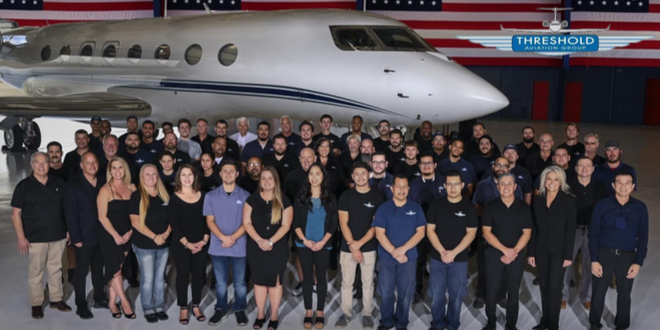Five of the Chino company’s eight executives are women, which is above average for aviation, an industry long dominated by men. But that might be starting to change.
Mark DiLullo is the owner and Chief Executive Officer of Threshold Aviation Group (“TAG”), located at the Chino, California Airport. The Threshold Aviation Group of Companies includes two Fixed Base Operations (“FBOs”), an FAA Approved Part 145 Repair Station, an Aircraft Management Company, a Business Jet Sales Division, and an FAA Part 135 Air Carrier operating Charter Flights in large cabin aircraft Worldwide.
Threshold employs more than 130 people and occupies approximately 175,000 square feet of hangar, shop and office space at the airport which is owned by San Bernardino County. The company’s facilities are located next to the airport’s 7,000-foot runway.
62% of Threshold’s executives are women:
- Lisa DiLullo serves as President of theThreshold Companies.
- Nicole DiLullo is the Companies Director of FBO and HR Services.
- Khera Turner is the Chief Inspector for the TAG Group’s Repair Station.
- Maggie Ortega is the Group of Companies Senior Accountant and Director of Customer Services.
- Helen Carpenter serves as the Chief Financial Officer for TAG Global, the Air Carrier/Charter Division
Today, one might expect an executive staff to be more than 20 percent female. But if you apply that standard to Threshold, you don’t know the aviation industry, which is overwhelmingly dominated by men, said Kevin Sullivan, an Oakland-based safety inspector for the Federal Aviation Administration. “That number is better than average,” Sullivan said. “Go anywhere in the country and you won’t find many women in management positions in aviation. There’s a lot of backward thinking in the industry. It doesn’t recognize strong women and how much they can get done, and that the more diverse you are the more successful you’re likely to be. ”The idea that women aren’t as technically-oriented and can’t solve problems is outdated thinking,
Turner is especially unique because of her job title, according to Sullivan. “The chief inspector is probably the most important person in any aviation operation,” said Sullivan, who has known the DiLullo’s for years and has consulted for Threshold. “One phone call to the FAA and no one can do anything. They can’t work on a plane or put fuel in it. Not many women have that job title.”
Threshold looks to put the most qualified person in any job regardless of gender or race. “I’m color-blind,” the elder DiLullo said. “I just want the most-qualified person in every job.”
The bias against women in aviation can be traced to the origins of airplane flight, when women, with a handful of exceptions, were thought to be incompatible with flying a plane, Sullivan said. In 1911, journalist Harriet Quimbly became the first woman in the United States to receive a pilot’s license. As for the first female commercial pilot, accounts vary. The most likely person to hold that distinction is Bonnie Tiburzi who was hired by American Airlines in 1973, Sullivan said.
It wasn’t until First Lady Eleanor Roosevelt began to promote female aviation that things began to change, according to Sullivan. “She flew with women pilots and she made women being pilots an issue,” Sullivan said. “If she hadn’t done that things would have moved slower.” Other possible reasons why few women hold management positions in aviation: the industry is filled with people who once served in the military, which is dominated by men, and there’s the “glass ceiling” – applicable to all professions – that maintains there’s an unofficial barrier to career advancement for women and minorities. “There’s a lot of backward thinking in the industry,” Sullivan said. “The idea that women aren’t as technically-oriented and can’t solve problems is outdated thinking, but it’s still out there, unfortunately.”
Whatever the reason, women are under-represented in the upper ranks of U.S. aviation, with the biggest gender gap found in technical operations and leadership positions, according to a 2019 study conducted by the University of Nebraska-Omaha. Women make up less than 10 percent of pilots, maintenance technicians, and airline executives, despite “continued outreach” in those areas, the report found. Specifically, only three percent of airline executives are women and only one percent are airline captains.
Areas in need of improvement include pilots, maintenance technicians, aerospace engineers, dispatchers, cybersecurity experts, airport managers, and air traffic controllers. There also needs to be more effort to put women in leadership positions in aviation, according to the report. “While increasing the number of women on the flight deck is important, it is equally important to increase the number of women in the [captain’s] seat, and the number of women in board seats,” the report states.
Another report, “Soaring Through the Glass Ceiling,” compiled by six major high-ranking officials in the aerospace industry found that nearly 20 percent of the chief executive officers in the U.S, aviation industry are women, compared with the five percent rate found in all industries. However, only three percent of global airline chief executives are female, and there’s little reason to expect that number to increase soon, according to the report, which was released one year ago.
Still, there are reasons to be encouraged. U.S. Secretary of Transportation Pete Buttigieg is calling for more women and minorities to hold executive positions in transportation, and United Airlines this month pledged that at least half of the 5,000 pilots it plans to train during the next 10 years will be either women or people of color. Currently, less than 20 percent of its pilots fall into that category, according to a statement released by the airline. “Our flight deck should reflect the diverse group of people on board our planes every day,” the airline stated.
 IE Business Daily Business news for the Inland Empire.
IE Business Daily Business news for the Inland Empire.


